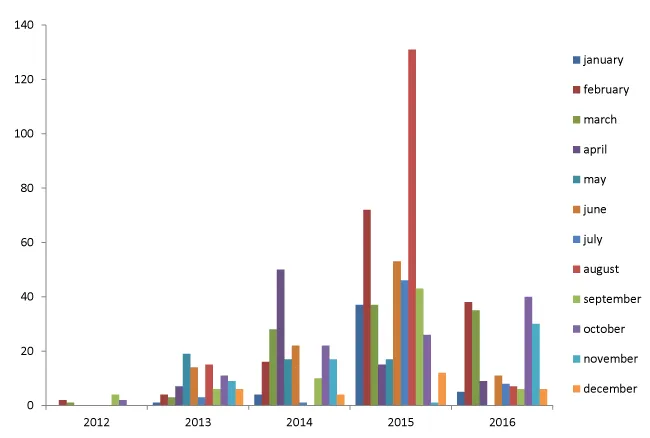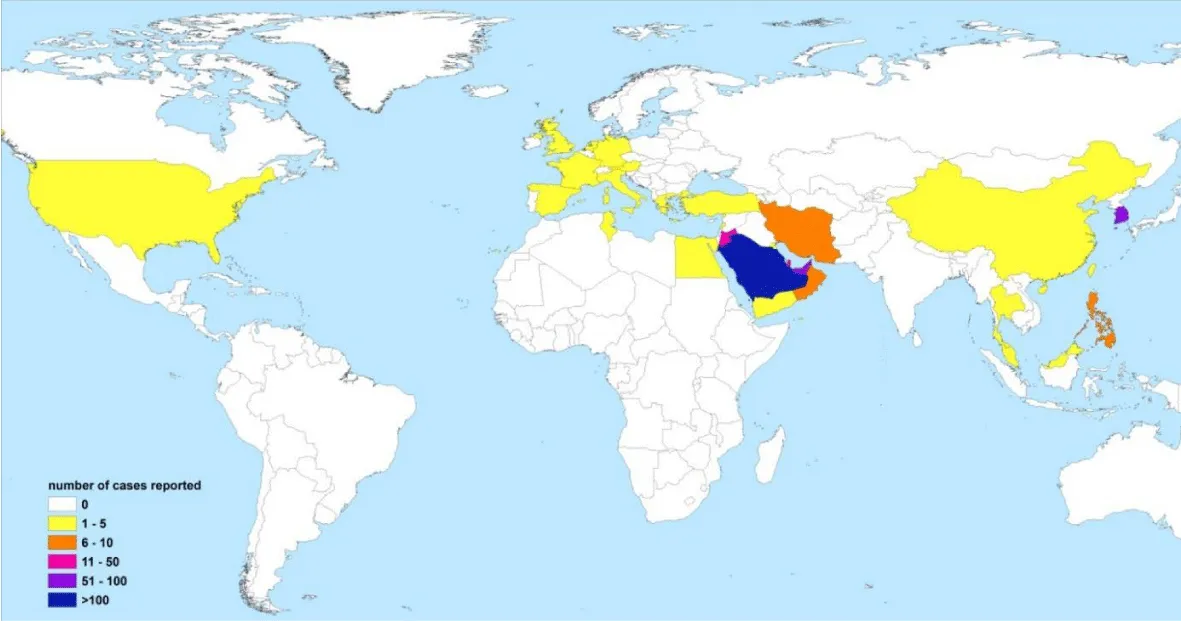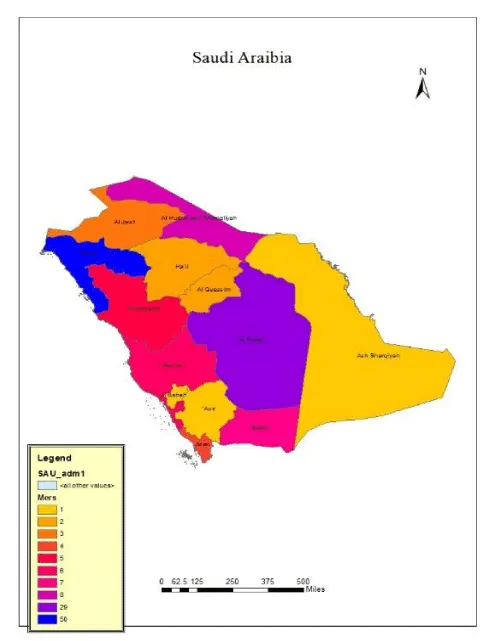Global Journal of Rare Diseases
A bird’s-eye view to the monthly pattern of Middle East Respiratory Syndrome Coronavirus (MERS-CoV) in the world, 2012 until 2016
Kazhal Mobaraki and Jamal Ahmadzadeh*
Cite this as
Mobaraki K, Ahmadzadeh J (2019) A bird’s-eye view to the monthly pattern of Middle East Respiratory Syndrome Coronavirus (MERS-CoV) in the world, 2012 until 2016. Glob J Rare Dis 4(1): 007-008. DOI: 10.17352/2640-7876.000013Emerging infections represent a concern especially when their increase is rapid and their mortality is high [1]. Middle East Respiratory Syndrome coronavirus (MERS-CoV) with high intensity and lethality and unknown epidemiological aspects is one of the emerging infections which should be considered as a threat to global health security [2]. This emerging infection first appeared in the September 2012 from a patient with fatal pneumonia in Jeddah district in Saudi Arabia, where every year a large number of Muslims attend the Hajj, one of the greatest Islamic rituals [3]. Subsequently, since September 2012, sporadic cases were reported from 27 countries in the world. To the best of researchers’ knowledge, to date, the authors of all previously published studies of MERS-CoV have neglected to calculate the monthly pattern of MERS-CoV infection from year to year. In this manuscript, we utilized a publicly available MERS-CoV database of case reports (n=1103 MERS cases) retrieved from the disease outbreak news on MERS-CoV in the world health organization (WHO) website (https://www.who.int/csr/don/archive/disease/coronavirus_infections/en) from 23 September of 2012 and 11 November of 2016. Epidemiological curve, monthly trend and global geographic distribution of the MERS-CoV cases during the course of this study summarized in figures 1, 2a,b.
The trend of new cases of MERS-CoV in different months from 2012 to 2016 was shown in figure 1. This figure shows the occurrence of some laboratory-confirmed MERS-CoV cases during each year, but every year we encounter with two peaks of this infection especially at the first and last months of each year.
This issue is better appreciated in the graph for 2015 in which two peaks were evident, the first peak is related to cold months (February, March, and April) and the second was occurred in warmer months of the year (May, June, July, and August), (Figure 1). This finding probably reflects the effect of the accumulation of indoor air during the cold months, which increases the rate of spread of the disease. Also, the peak of infection seen during the warmer months coincides with the largest mass gathering of Muslims around the world in Saudi Arabia (where it is reported that >80% of MERS-CoV cases occur worldwide) to perform the Hajj and Umrah ceremonies. All this is evidence that the virus seems to pass easily from person to person, particularly in close contact. The trends of incidence of MERS-CoV in the different months within the study period also indicate a downward trend of reported MERS-CoV cases from 2015 to 2016 in figure 1 which was due to the effective involvement of the national health authorities.
The scattered distribution and high incidence of cases of MERS-CoV infection and its associated mortality globally indicate the threat this disease poses to public health. The pattern of the global distribution of MERS-CoV shows that Saudi Arabia must be considered as the epicenter of this pandemic (Figure 2 (a)). Our findings also show that the highest prevalences of MERS-CoV infection were found in Tabuk and Riyadh, both provinces in Saudi Arabia (Figure 2 (b)).
In summary, since our knowledge about the epidemiology of MERS-CoV is increasing, there is the need to continuously design and conduct studies to characterize certain ecological and epidemiological trends of MERS-CoV infection and also determine the geographic distribution of MERS-CoV to take preventive action and develop effective interventions. We hope that this manuscript be as a basis for further epidemiological research in this scope, especially for considering the seasonal pattern of the MERS-CoV infection in the human community.
The authors take this opportunity to thank all the WHO personnel as well as reporting countries with confirmed MERS cases for data collection and sending the data to WHO. This paper is dedicated to our beloved children Arsam Ahmadzadeh and Anil Ahmadzadeh.
- Bradley BT, Bryan A (2019) Emerging Respiratory Infections: The infectious disease pathology of SARS, MERS, pandemic influenza, and Legionella. Seminars in diagnostic pathology. 36: 152-159. Link: http://bit.ly/2Gdm9a5
- Mobaraki K, Ahmadzadeh J (2019) Current epidemiological status of Middle East respiratory syndrome coronavirus in the world from 1.1. 2017 to 17.1. 2018: a cross-sectional study. BMC Infect Dis 19: 351. Link: http://bit.ly/2LV1ATB
- Mobaraki K, Ahmadzadeh J (2019) An update to middle east respiratory syndrome coronavirus and risk of a pandemic in 2019. Clin Microbiol Infect Dis 4: 1-2. Link: http://bit.ly/2LjoggF

Article Alerts
Subscribe to our articles alerts and stay tuned.
 This work is licensed under a Creative Commons Attribution 4.0 International License.
This work is licensed under a Creative Commons Attribution 4.0 International License.



 Save to Mendeley
Save to Mendeley
